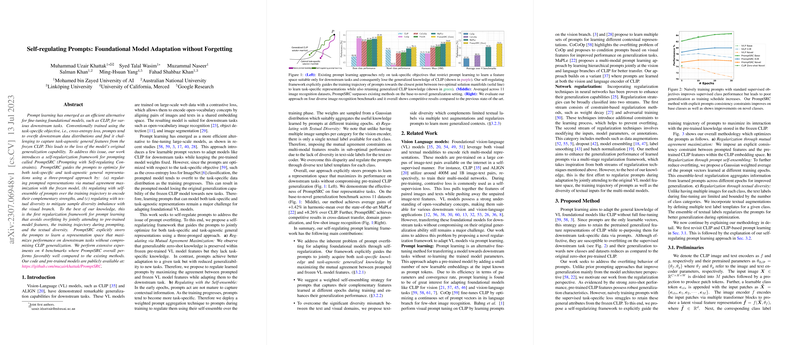Overview of "Self-regulating Prompts: Foundational Model Adaptation without Forgetting"
The paper "Self-regulating Prompts: Foundational Model Adaptation without Forgetting" dives into the domain of prompt learning, particularly focusing on adapting foundational vision-language (VL) models, such as CLIP, without compromising their inherent generalization capabilities. This research addresses a significant challenge in prompt learning where the conventional methods often lead to overfitting, thus diminishing the generalization prowess of the pre-trained models.
Key Contributions and Methodology
The central proposition of this paper is the development of the PromptSRC framework which introduces a self-regularization mechanism to optimize prompts. The researchers identify that existing methods primarily focus on task-specific objectives, which results in a narrowed feature space that overlooks the broader, generalized knowledge ingrained in models like CLIP. To mitigate this, the paper proposes a three-pronged self-regulation approach:
- Mutual Agreement Maximization: This aspect introduces a constraint that aligns the generated prompted features with their frozen counterparts in the model. Through the use of consistency losses, both at the feature and logit levels, this component ensures that the learning trajectory of prompts remains close to the original generalized feature space inherent to CLIP.
- Self-ensembling of Prompts: Addressing the variance in prompt efficacy at different training stages, this component aggregates prompts using a Gaussian weighted mechanism throughout the training timeline. By selectively emphasizing prompts from middle epochs and incorporating knowledge from various training stages, the approach stabilizes prompt learning outcomes.
- Textual Diversity Utilization: Acknowledging the disparity in sample diversity between visual inputs and text labels, this strategy enhances the prompts' exposure to diverse text representations. By leveraging multiple text augmentations during training, it ensures a balanced and enriched input repertoire, thus promoting the acquisition of more generalized task representations.
Empirical Evaluation
Extensive experimentation is conducted across four benchmarks: base-to-novel class generalization, few-shot learning, domain generalization, and cross-dataset evaluation. PromptSRC consistently enhances the performance across these benchmarks, especially notable in the few-shot learning scenario where it significantly outperforms existing approaches in scenarios with limited data availability. The framework also demonstrates superior capacity in maintaining, and even enhancing, generalization on novel tasks when compared to baseline and other state-of-the-art prompt learning models.
Implications and Future Directions
The implications of this research are manifold. Practically, it enhances the versatility of pre-trained models like CLIP to transfer learning applications across diverse downstream tasks without extensive re-training while preserving their broad-spectrum utility. Theoretically, it sets a precedent in enforcing regularization within prompt learning through self-regulatory constraints. Future explorations could delve into the scalability of these self-regulating techniques across newer foundational models with more complex architectures and further investigate dynamic prompt adaptation strategies that incorporate real-time feedback.
Conclusion
"Self-regulating Prompts: Foundational Model Adaptation without Forgetting" significantly advances the prompt learning landscape by providing a robust framework that remedies the overfitting issue prevalent in adaptation tasks. By introducing novel self-regulation components, it both preserves and extends the generalization strengths of foundational models, offering a balanced paradigm for future research endeavors in the field of model adaptation and transfer learning.
